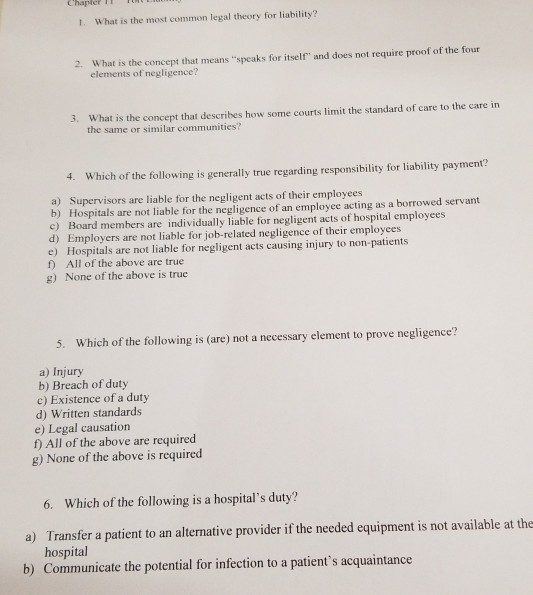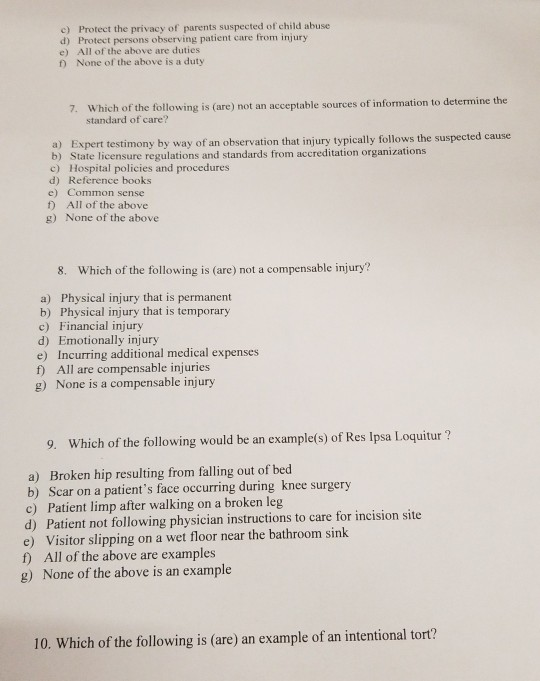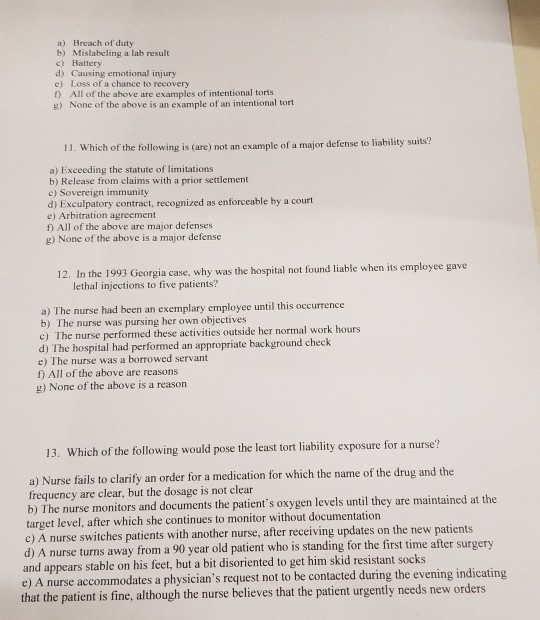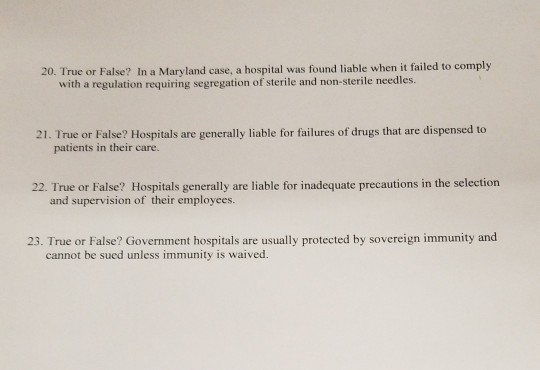Answered step by step
Verified Expert Solution
Question
1 Approved Answer
Chapter 1 What is the most common legal theory for liability? 2. What is the concept that means speaks for itself and does not require





Chapter 1 What is the most common legal theory for liability? 2. What is the concept that means "speaks for itself" and does not require proof of the four elements of negligence? 3. What is the concept that describes how some courts limit the standard of care to the care in the same or similar communities? 4. Which of the following is generally true regarding responsibility for liability payment? a) Supervisors are liable for the negligent acts of their employees b) Hospitals are not liable for the negligence of an employee acting as a borrowed servant c) Board members are individually liable for negligent acts of hospital employees d) Employers are not liable for job-related negligence of their employees e) Hospitals are not liable for negligent acts causing injury to non-patients f) All of the above are true g) None of the above is true 5. Which of the following is (are) not a necessary element to prove negligence? a) Injury b) Breach of duty c) Existence of a duty d) Written standards e) Legal causation f) All of the above are required g) None of the above is required 6. Which of the following is a hospital's duty? a) Transfer a patient to an alternative provider if the needed equipment is not available at the hospital b) Communicate the potential for infection to a patient's acquaintance c) Protect the privacy of parents suspected of child abuse d) Protect persons observing patient care from injury e) All of the above are duties f None of the above is a duty 7. Which of the following is (are) not an acceptable sources of information to determine the standard of care? a) Expert testimony by way of an observation that injury typically follows the suspected cause b) State licensure regulations and standards from accreditation organizations c) Hospital policies and procedures d) Reference books e) Common sense f) All of the above g) None of the above 8. Which of the following is (are) not a compensable injury? a) Physical injury that is permanent b) Physical injury that is temporary c) Financial injury d) Emotionally injury e) Incurring additional medical expenses f) All are compensable injuries g) None is a compensable injury 9. Which of the following would be an example(s) of Res Ipsa Loquitur ? a) Broken hip resulting from falling out of bed b) Scar on a patient's face occurring during knee surgery c) Patient limp after walking on a broken leg d) Patient not following physician instructions to care for incision site e) Visitor slipping on a wet floor near the bathroom sink f) All of the above are examples g) None of the above is an example 10. Which of the following is (are) an example of an intentional tort? a) Breach of duty b) Mislabeling a lab result c) Battery d) Causing emotional injury e) Loss of a chance to recovery f) All of the above are examples of intentional torts 8) None of the above is an example of an intentional tort 11. Which of the following is (are) not an example of a major defense to liability suits? a) Exceeding the statute of limitations b) Release from claims with a prior settlement c) Sovereign immunity d) Exculpatory contract, recognized as enforceable by a court e) Arbitration agreement f) All of the above are major defenses g) None of the above is a major defense 12. In the 1993 Georgia case, why was the hospital not found liable when its employee gave lethal injections to five patients? a) The nurse had been an exemplary employee until this occurrence b) The nurse was pursing her own objectives c) The nurse performed these activities outside her normal work hours d) The hospital had performed an appropriate background check e) The nurse was a borrowed servant 1) All of the above are reasons g) None of the above is a reason 13. Which of the following would pose the least tort liability exposure for a nurse? a) Nurse fails to clarify an order for a medication for which the name of the drug and the frequency are clear, but the dosage is not clear b) The nurse monitors and documents the patient's oxygen levels until they are maintained at the target level, after which she continues to monitor without documentation c) A nurse switches patients with another nurse, after receiving updates on the new patients d) A nurse turns away from a 90 year old patient who is standing for the first time after surgery and appears stable on his feet, but a bit disoriented to get him skid resistant socks e) A nurse accommodates a physician's request not to be contacted during the evening indicating that the patient is fine, although the nurse believes that the patient urgently needs new orders 14. Which of the following is (are) not an example of tort liability for radiology? a) Delays in diagnosis b) Lack of disclosure of risk of radiation injury c) Performing procedures with no beneficial value d) Radiation injury e) Falls from positioning a patient f) All of the above are examples g) None of the above is an example 15. Which of the following is (are) not an example of tort liability for a supervisor? a) Allocates the available staff in a manner that is likely to cause injury b) Observes an act likely to cause injury and waits until the end of the shift to take action and does so by discussing the act with the employee c) Asks a nurse's aid to perform a task beyond her level of competency d) Does not monitor a newly graduated nurse on her first week of work e) Assigns a nurse a task within her licensed scope of practice, but for which she has not had training 1) All of the above are examples g) None of the above is an example 16. True or False? It is important to monitor changes in procedures and outcomes of tort cases over time as they frequently change. 17. True or False? Generally, there is a common law duty of clinicians to come to the rescue of a person in imminent medical danger, even if the clinician is not on the job at the time. 18. True or False? Some courts limit the standard of care to the prevailing standards in the same or similar communities. 19. True or False? Courts may not impose standards that are more stringent than the general practice among physicians and hospitals in the particular community. 20. True or False? In a Maryland case, a hospital was found liable when it failed to comply with a regulation requiring segregation of sterile and non-sterile needles. 21. True or False? Hospitals are generally liable for failures of drugs that are dispensed to patients in their care. 22. True or False? Hospitals generally are liable for inadequate precautions in the selection and supervision of their employees. 23. True or False? Government hospitals are usually protected by sovereign immunity and cannot be sued unless immunity is waived
Step by Step Solution
There are 3 Steps involved in it
Step: 1

Get Instant Access to Expert-Tailored Solutions
See step-by-step solutions with expert insights and AI powered tools for academic success
Step: 2

Step: 3

Ace Your Homework with AI
Get the answers you need in no time with our AI-driven, step-by-step assistance
Get Started


